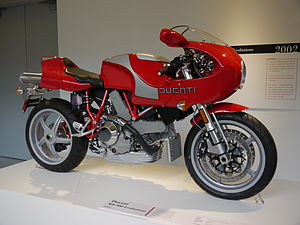Ducati MH900e
| Ducati | |
|---|---|

|
|
| MH900e (2002 model) | |
| Manufacturer | Ducati Motor Holding SpA |
| Production period | 2001 to 2002 |
| class | motorcycle |
| design type | Super athlete |
| Motor data | |
| Four-stroke engine , air / oil-cooled 90 ° twin cylinder, OHC , two desmodromic controlled valves per cylinder, compression 9.2: 1, electronic Marelli injection system, multi-plate dry clutch | |
| Displacement (cm³) | 904 |
| Power (kW / PS ) | 59/80 at 7,500 min -1 |
| Torque ( N m ) | 79 Nm at 6500 min -1 |
| transmission | 6-speed |
| drive | Chain drive , O-ring chain |
| Brakes | front two 320 mm disc brakes, 4-piston fixed calipers / rear 220 mm, 2-piston floating caliper |
| Wheelbase (mm) | 1,415 |
| Seat height (cm) | 850 |
| Empty weight (kg) | 186 (full tank) |
The Ducati MH900e is a supersport model limited to 2000 pieces by the Italian motorcycle manufacturer Ducati . It was presented at Intermot 1998 and produced in 2001 and 2002. The entire production was already sold out before delivery.
Model history
The motorcycle was designed by then Ducati chief designer Pierre Terblanche as a tribute to Mike Hailwood , who won the TT on the Isle of Man on Ducati in 1978.
In September 1998 a first draft was presented at the Intermot (at that time in Munich). Due to the positive reactions from the public and the press, Ducati published a questionnaire on the Internet to find out the actual interest. After the evaluation, those responsible Federico Minoli and Massimo Bordi decided to produce a special series of 2000 copies. The machines were sold directly to end customers exclusively via the Internet (so-called B2C business to customer), making Ducati the first motorcycle manufacturer to use this sales channel. On January 1, 2000, starting at 0.01 a.m., the model was offered at a price of 15,000 euros; the first 1,000 machines were sold after 31 minutes. About 30% of the customers came from Europe, 30% from the USA and 39% from Japan.
Design and technology
The design of the motorcycle should combine tradition and modernity. The look of a street racer from the 1970s was combined with modern technology. Most aspects of the study were actually implemented. However, instead of an exhaust with integrated indicators, a more conventional solution was used in the delivered models, and "normal" rear-view mirrors were installed instead of an integrated camera with a display.
The engine corresponded to the air-cooled 90 ° V-engine (Ducati designation due to the installation position: L-engine) with 904 cm³ displacement and 59 kW / 80 PS, which was used in the Ducati 900SS.
When the machine was delivered, the buyer received a T-shirt with the production number and a suitable stand to jack up; there is also a corresponding badge on the machine itself.
production
Most of the motorcycle was handcrafted in the factory in Bologna, producing four to five machines a day. Due to unexpected adjustments, production did not start until a year after the presentation and lasted until 2002, so that two different production years are known.
Litigation over the name
Pauline Hailwood, Mike Hailwood's widow, sued Ducati in 2001 for the unauthorized use of her late husband's name on the model. Mike Hailwood died in 1981 and had nothing to do with the development of the motorcycle. Ducati stated that the bike was "inspired" by Mike Hailwood's victory in the TT on the Isle of Man. The proceedings were discontinued in return for a subsequent license payment.
Web links
Individual evidence
- ↑ Presentation: Ducati study MH900e ( memento from November 29, 2014 in the Internet Archive ) in Motorrad from October 23, 1998, accessed on November 3, 2014
- ↑ Driving report Ducati MH 900 evoluzione in Motorrad from January 12, 2001, accessed on November 3, 2014
- ↑ Lecture 2008 by Oliver Bohl (English) at the University of Kassel, accessed on November 21, 2014
- ↑ Mike Hailwood's widow is suing Ducati ( memento from March 9, 2016 in the Internet Archive ) in Motorrad from October 1, 2001, accessed on November 21, 2014
